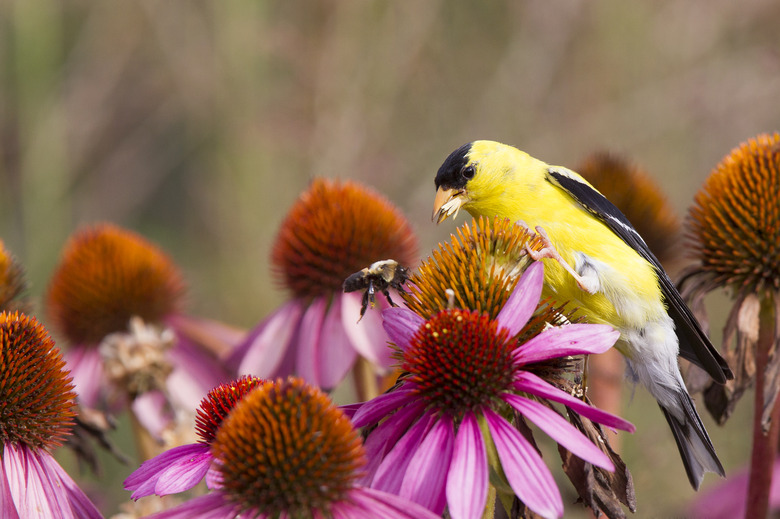How Do Birds Disperse Seeds?
How do seeds travel? Birds are important in the life cycle of many plants, because they aid in seed dispersal in a number of ways. Seeds need to move away from their parent plants – a process called seed dispersal – in order to have enough water, sun and space to germinate and grow.
Plants advertise their seeds to birds by providing colorful, energy-filled fruits or large nuts as a food source. Plants such as the bird cherry have evolved along with birds, reaching a point where their seeds require a pass through a bird's digestive system to help them prepare for germination. A relationship like this, where both organisms benefit, is called mutualism.
On Their Bodies
On Their Bodies
Seeds may attach to the feathers of birds or the fur of animals through structures present on the seed, such as small hooks or barbs. Birds may disperse seeds, such as those of mistletoe, by carrying them on their beaks after feeding. Mistletoe is a parasitic plant that attaches itself to other plants; it's not rooted in soil.
According to the University of Nevada, Las Vegas, the seeds of the mistletoe plant are covered in a sticky substance – birds wipe their beaks on a branch to rid themselves of the seeds, allowing mistletoe to reach the environment it prefers.
In Beaks or Claws
In Beaks or Claws
Birds may carry seeds to a new location in their beaks or claws. A bird may be planning a meal or building a nest, and fly off with a seed or fruit to a safe area. Along the way, the bird may be dropping seeds or whole fruits, allowing them to reach new spots, far from the parent plants where there are sufficient resources to thrive.
Birds may also drop seeds in or near water, helping them to travel further or reach a moist location. One large seed that travels by water is the coconut. Because birds can fly around barriers and slip into small spaces, they may carry seed to places where larger animals, the action of the wind or water may not.
Dispersal During Feeding
Dispersal During Feeding
The seeds of some plants, including the nuts of some large trees, serve as a food source for birds. Feeding birds may knock seeds from stems, cones and flower heads as they eat. While this may not spread the seeds far from the parent plants, it can cause the seeds to fall to the ground and bring the seeds into contact with the soil, where they can overwinter and germinate into a new generation of plants.
Birds may also partially crack or nick the seed coat trying to open a seed, allowing it to more easily germinate. According to The Seed Site, other plants depend on birds and other animals to forget where they have hidden or buried seeds, effectively distributing the seeds and allowing them to colonize a new area. The acorns of oak trees are often dispersed in this way.
Dispersal Through Droppings
Dispersal Through Droppings
In some cases, birds do not digest and receive energy from the seeds they consume. Instead, they seek the nutritious fruits and berries surrounding the seeds, and the seeds come along with the bargain, notes Cornell University's Naturalist Outreach. Examples of plants that use this seed dispersal method include raspberries, blackberries and blueberries.
Birds ingest the flavorful pulp; the seeds inside the pulp then move through the birds' digestive systems and are passed out along with their droppings. The fecal material gives seeds a small dose of fertilizer as they germinate and begin to grow. High in nitrogen, the excrement can help fuel the development of foliage in the young plants growing in new places.
Cite This Article
MLA
Moon, Alice. "How Do Birds Disperse Seeds?" sciencing.com, https://www.sciencing.com/how-do-birds-disperse-seeds-12517955/. 30 September 2021.
APA
Moon, Alice. (2021, September 30). How Do Birds Disperse Seeds?. sciencing.com. Retrieved from https://www.sciencing.com/how-do-birds-disperse-seeds-12517955/
Chicago
Moon, Alice. How Do Birds Disperse Seeds? last modified March 24, 2022. https://www.sciencing.com/how-do-birds-disperse-seeds-12517955/
